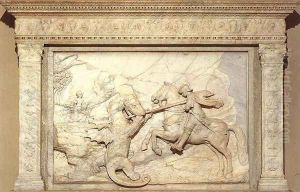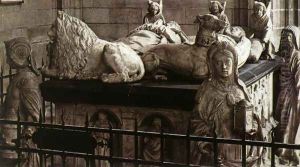Michel Colombe Paintings
Michel Colombe is a significant figure in the history of French sculpture, whose work marked a transition from the late Gothic to the early Renaissance style. Born around 1430, likely in Bourges, France, Colombe's life and career spanned the late 15th and early 16th centuries, a period that saw profound changes in art, culture, and society. His exact date of birth is uncertain, as is much of his early life, but what is known is that he emerged as a master sculptor, whose works would leave a lasting imprint on the French sculptural tradition.
Colombe's career is noted for its longevity and productivity, with his most active period being the last two decades of the 15th century through to his death around 1513. He is best remembered for his work on the tomb of Francis II, Duke of Brittany, and his wife Marguerite de Foix, which he completed in the early 1500s for the Cathedral of Nantes. This masterpiece is considered one of the pinnacles of French sculpture, combining the detailed Gothic sensibilities of his predecessors with the emerging Renaissance emphasis on humanism and naturalism.
Despite the paucity of records regarding his training and early works, it is believed that Colombe came from a family of artisans and was trained in the Burgundian style, which was the dominant sculptural style in France during his youth. Over his career, he developed a distinctive style that incorporated elements of the Italian Renaissance, which he may have been exposed to through the influx of Italian artists and artworks into France during this period. His works are characterized by their intricate detail, emotional depth, and the use of spatial composition to convey narrative and drama.
Michel Colombe's influence extended beyond his lifetime, setting the stage for the full flowering of the Renaissance in French sculpture. His approach to sculptural composition, his integration of architectural elements, and his expressive use of the human form influenced a generation of sculptors. Despite the limited number of works that can be securely attributed to him, Colombe's legacy is that of a pivotal figure in the transition from medieval to Renaissance art in France. His death around 1513 marked the end of an era, but his artistic contributions continue to be celebrated for their innovation, craftsmanship, and beauty.

